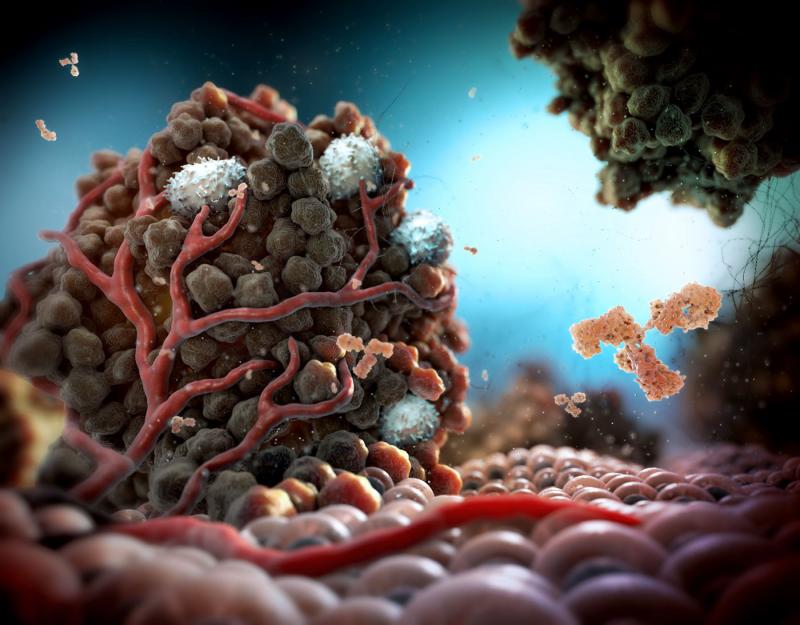What is the Tumor Microenvironment?
The tumor microenvironment refers to the cellular environment that surrounds and interacts with cancer cells. It consists of a variety of cell types in addition to cancer cells, including fibroblasts, immune cells, blood vessels, extracellular matrix, as well as soluble molecular factors. Together, these components create a unique microenvironment that plays an important role in cancer initiation, progression, invasion, and metastasis. While cancer cells were originally thought to be primarily responsible for driving tumor growth, it is now clear that the tumor microenvironment plays an influential role in cancer progression through complex biochemical signaling pathways and interactions between different cell types.
Components of the Tumor Microenvironment
Fibroblasts are a major cellular component of the tumor microenvironment and are often referred to as cancer-associated fibroblasts. These activated fibroblasts secrete growth factors, cytokines, and chemokines that promote cancer cell proliferation, survival, angiogenesis, and invasion. Immune cells, including tumor-associated macrophages, myeloid-derived suppressor cells, and lymphocytes also infiltrate the tumor and influence cancer progression through various mechanisms. Specifically, tumor-associated macrophages secrete factors that promote angiogenesis, suppress anti-tumor immune responses, and stimulate cancer cell invasion and metastasis.
The Tumor Microenvironment also contains an extracellular matrix composed of collagen, fibronectin, and proteoglycans. Tumor cells alter the composition and biochemical properties of this matrix to promote growth, invasion, and metastases. Blood vessels are recruited to the tumor through angiogenesis to supply nutrients necessary for growth. This vascularization induced by tumors is crucially important for tumor progression. Finally, various soluble factors including growth factors, cytokines, chemokines, and metabolites present in the extracellular milieu contribute to creating a microenvironment conducive to cancer.
Interactions Between Cancer Cells and the Microenvironment
A dynamic and complex network of interactions exists between cancer cells and the various components of the tumor microenvironment. Cancer cells secrete factors that recruit and educate fibroblasts, immune cells, and endothelial cells. For example, factors secreted by tumor cells induce the activation and recruitment of fibroblasts, which then acquire a cancer-associated phenotype. These cancer-associated fibroblasts secrete paracrine factors that stimulate tumor cell proliferation, survival, and invasive potential. Cancer cells also influence immune cells in the tumor microenvironment by educating macrophages towards an alternative activation state which supports tumor progression.
In addition, tumor cells activate various signaling pathways through paracrine mechanisms involving growth factors, cytokines, and extracellular matrix interactions. For example, growth factors like EGF, FGF, and PDGF produced in the tumor microenvironment stimulate cancer cell proliferation and survival through autocrine and paracrine mechanisms. Extracellular matrix interactions between cancer cells and fibronectin or collagen also activate pro-tumorigenic signaling pathways like FAK/Src and integrin signaling. Together, these complex interactions between cancer cells and the surrounding microenvironment create a permissive niche that allows tumors to grow, evolve, and spread to distant sites.
Impact on Cancer Progression
The dynamic interplay between cancer cells and the heterogeneous cell types and molecular signals that constitute the tumor microenvironment profoundly impacts cancer progression at each step. During tumor initiation, a pro-inflammatory microenvironment stimulates pre-malignant cells to acquire cancer-promoting mutations through increased oxidative stress and DNA damage. During primary tumor growth, factors secreted by cancer cells recruit various stromal cells and induce angiogenesis to fuel nutrient delivery necessary for rapid proliferation. In many carcinomas, stromal cell recruitment and angiogenesis precede actual neoplastic transformation and tumor formation.
At the invasive front, proteases produced by cancer cells and stromal cells degrade the extracellular matrix to enable physical break down of basement membranes and tissue barriers. Inflammatory cytokines and growth factors produced in the microenvironment activate pro-migratory and pro-invasive pathways in cancer cells. During intravasation into blood vessels, macrophages and fibroblasts promote vascular permeability to aid entrance of cancer cells into circulation. Finally, at pre-metastatic sites conditioned by molecules derived from primary tumors, microenvironment-derived cytokines and exosomes prepare niches to support survival and outgrowth of disseminated cancer cells into overt metastases. Together, these interactions illustrate how the microenvironment acts as an indispensable collaborator and facilitator at each step of the metastatic cascade.
Therapeutic Implications
Given its prominent role in supporting cancer progression, targeting the tumor microenvironment represents an appealing strategy for improving current therapies. Drugs targeting specific signaling pathways, cell types, and molecules involved in microenvironment-cancer cell crosstalk are in development. Anti-angiogenic agents target the vascular component, while drugs aimed at modulating the immune cell composition are also being tested. Extracellular matrix modifiers and drugs targeting inflammatory cytokines and growth factors represent additional therapeutic avenues. Combination therapies targeting both cancer cells and the microenvironment simultaneously may achieve greater efficacy than conventional anti-cancer agents alone by preventing compensatory responses from the microenvironment. Overall, a deeper understanding of tumor-stroma interactions is crucial to devise better methods to disrupt the supportive tumor microenvironment and improve clinical outcomes for cancer patients.
Get more insights on Tumor Microenvironment
